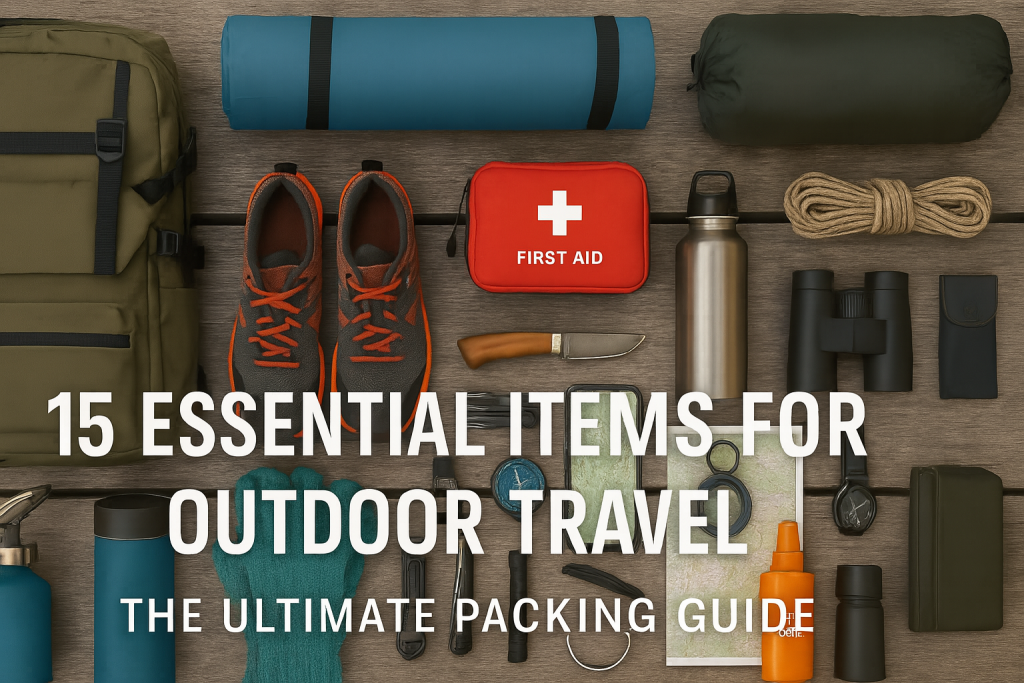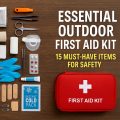Why Packing the Right Outdoor Essentials Matters
Whether you are planning a weekend hike, a multi-day backpacking trip, or an adventurous camping excursion, having the right outdoor travel gear can make or break your experience. Being well-prepared not only enhances your comfort, but also guarantees safety and peace of mind during unpredictable adventures. No matter your experience level, knowing what to pack is crucial for every outdoor traveler.
Outdoor environments can be challenging, with fluctuating weather, rugged terrain, and unexpected situations. By preparing a well-thought-out packing list, you minimize risks and maximize your enjoyment. In this comprehensive guide, discover the 15 essential items for outdoor travel that seasoned explorers never leave behind.
1. Reliable Backpack
Your journey begins with choosing the right backpack. It serves as the foundation for your gear organization and comfort. Select a pack with adequate capacity—daypacks (20-30L) for short hikes or larger backpacks (40-70L) for multi-day trips. Look for ergonomic straps, ventilation, and accessible compartments for easy packing and carrying.
Extra features like hydration bladder compatibility, rain covers, and adjustable frames can make a significant difference in longer adventures. Remember, a quality backpack should balance durability with lightweight materials to reduce fatigue on the trail.
2. Navigation Tools
Map and Compass
In an era of smartphones, traditional navigation tools like a topographic map and compass are still vital. GPS devices can fail or lose signal in remote areas, but maps and compasses function independently of batteries or reception.
Digital Navigation
Supplement your navigation with GPS-enabled devices or mapping apps on your smartphone. Download offline maps ahead of time, and always carry a backup power bank to ensure your electronics remain functional throughout your trip.
3. Hydration System
Staying hydrated is critical for energy, cognition, and overall well-being. Carry an adequate water supply based on your trip’s duration and climate. Hydration reservoirs or water bottles are both excellent options, and many hikers prefer a combination of both for flexibility.
Include a water purification method, such as a filter, purification tablets, or UV purifiers, especially in areas where water sources are questionable. Never underestimate the importance of clean water.
4. Appropriate Clothing
Layering System
Packing the right clothing means preparing for any weather. The golden rule is layering: a moisture-wicking base layer, insulating mid-layer, and waterproof/windproof outer shell. Each layer serves a specific purpose, allowing you to adapt to changing temperatures and conditions.
Additional Apparel
Include a hat, gloves, extra socks, and sun protection. Quick-drying, breathable fabrics outperform cotton in outdoor situations by preventing hypothermia and discomfort. Always check the forecast and adjust your clothing accordingly.
5. Food and Nutrition
Pack nutrient-dense, lightweight foods such as trail mix, energy bars, jerky, dried fruits, and dehydrated meals. Proper nutrition keeps your energy up and morale high. Plan portions for each meal and consider your energy expenditure throughout the day.
If you’re embarking on longer journeys, a compact stove, fuel, and cooking utensils may be necessary. Always adhere to Leave No Trace ethics—pack out all trash and leftovers.
6. Shelter and Sleep System
Tent or Alternative Shelter
Your choice of shelter depends on the terrain and expected weather. Lightweight tents, bivy sacks, or hammocks with rain flies are popular among outdoor travelers. Make sure your shelter is easy to set up and provides adequate protection from the elements.
Sleeping Bag and Pad
Bring a sleeping bag rated for the lowest temperature you anticipate, and a sleeping pad for insulation and comfort. A good night’s sleep is essential for recovery and enjoyment on the trail.
7. First Aid Kit
Injuries and ailments can happen unexpectedly. Carry a well-stocked first aid kit with bandages, antiseptics, blister treatment, pain relievers, allergy medications, and any personal prescriptions. Familiarize yourself with basic first aid techniques before your trip.
Customize your kit to match your destination, group size, and duration. Pro tip: add a compact emergency manual or cheat sheet for quick reference.
8. Multi-Tool or Knife
A versatile multi-tool or sturdy knife is indispensable. It serves countless purposes, from meal preparation and gear repair to emergency situations. Choose a lightweight option with practical features like scissors, screwdrivers, and can openers.
Keep your tool accessible and well-maintained. For air travel, remember to stow knives and multi-tools in checked luggage.
9. Fire-Starting Equipment
Fire provides warmth, light, and a way to cook food. Pack multiple fire-starting methods such as waterproof matches, lighters, and fire starters. Store them in a waterproof pouch or container.
Before heading out, practice using your fire gear. Fire safety is paramount—never leave flames unattended and follow all local regulations regarding open fires.
10. Headlamp or Flashlight
After the sun sets, a reliable light source is invaluable. Headlamps are favored for their hands-free convenience, while compact LED flashlights serve as excellent backups. Always carry spare batteries or a rechargeable power supply.
Use red-light settings at night to preserve night vision and minimize disturbance to wildlife or fellow travelers.
11. Sun Protection
UV exposure can quickly lead to sunburn and long-term skin damage. Pack broad-spectrum sunscreen (SPF 30 or higher), lip balm with SPF, sunglasses with UV protection, and a wide-brim hat.
Wear long sleeves or sun-protective clothing for extended time in open environments. Reapply sunscreen regularly, especially after sweating or swimming.
12. Insect Protection
Depending on your destination, insects like mosquitoes and ticks can pose annoyance or even health risks. Insect repellent is a must-have—choose one with DEET, picaridin, or natural alternatives like lemon eucalyptus oil.
Consider packing a lightweight mosquito net or treated clothing in high-infestation areas. Inspect yourself regularly for ticks, and know how to remove them safely.
13. Emergency Communication Device
Cell service is unreliable in many remote areas. Carry a personal locator beacon (PLB) or a satellite messenger to communicate in emergencies. These devices can alert search and rescue teams to your location if you become lost or injured.
Let someone at home know your itinerary and check in regularly. Redundancy in communication can be lifesaving.
14. Personal Identification and Essential Documents
Always keep your ID, insurance card, permits, and any necessary travel documents in a waterproof bag. Some destinations require permits or proof of reservations. Having these items easily accessible can prevent unnecessary complications.
For international trips, add passport copies and emergency contact information to your kit. Store digital copies securely online for extra peace of mind.
15. Trash Bags and Leave No Trace Supplies
Responsible outdoor travel means leaving nature as you found it—or better. Carry trash bags to pack out all waste, including biodegradable items. Practice the Leave No Trace principles to protect wild spaces for future adventurers.
Additional supplies like trowels for digging catholes, biodegradable soap, and reusable utensils can minimize your environmental impact and contribute to cleaner trails and campsites.
Pro Tips for Efficient Packing
- Make a checklist before every trip and review it as you pack.
- Group similar items together in waterproof stuff sacks for organization.
- Test new gear at home to ensure familiarity and functionality.
- Adjust your essentials based on the number of days, expected weather, and group needs.
By packing smart and prioritizing these essential outdoor travel items, you can confidently embark on any adventure, knowing you’re well-prepared for whatever the wilderness may bring.
Conclusion: Enjoy Your Outdoor Adventures with Confidence
Preparation is the key to safe, enjoyable, and memorable outdoor experiences. With these 15 essential items for outdoor travel in your backpack, you’ll be ready to face challenges, adapt to changing conditions, and fully immerse yourself in the beauty of nature. Remember, the best outdoor adventures begin with smart planning and conscious packing—so gear up, explore, and enjoy the journey!


